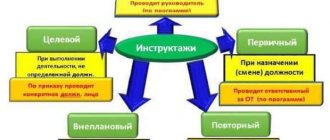Who should be trained
According to clause 2.1.1 of the Procedure, all persons hired for work must undergo training. It is also mandatory for employees who are transferred to another job.
REFERENCE
Is safety training necessary for a person who is not on the company’s staff, but performs work or provides services under a civil contract? The answer depends on the terms of the contract. If it states that the customer pays insurance premiums “for injuries” for the contractor (performer), then training should be carried out. This opinion was expressed by the Ministry of Labor in letter No. PG/02487-6-1 dated February 21, 2020 (see “Labor safety: is it necessary to instruct workers with whom GPC agreements have been concluded?”).
What is the occupational safety service responsible for?
The area of responsibility of the occupational safety service, which can be represented even by a single engineer, is the organization of occupational health and safety at the enterprise. Representatives of this service are obliged to:
1. Organize an investigation, recording of NS, PP, analysis of the causes of their occurrence, development of preventive measures;
2. Create and implement programs and activities to improve the quality of working conditions;
3. Provide organizational and methodological support to departments in the field of occupational safety: help develop instructions on safety and labor protection, store their control copies, provide departments and management employees with instructions, magazines, cards, other documentation on occupational safety, visual aids, rules, regulations;
4. Participate in testing workers’ knowledge based on the results of occupational safety training conducted by the enterprise;
5. Help prepare any documents that relate to labor protection and safety at work: collective agreement, various agreements, orders for calls to work on weekends, changes in schedule, etc.;
6. Help make lists for:
• passing pre-shift, preliminary and annual medical examinations; • receiving milk, special food; • issuance of protective clothing and personal protective equipment; • receiving compensation (preferential pension provision, additional leave);
7. Prepare and submit labor safety reports;
8. Store OT documentation;
9. Organize training on occupational safety for employees and managers;
10. Regularly check the health status in departments;
11. Conduct introductory briefings on labor protection and safety precautions.
In order to effectively monitor compliance with occupational health and safety requirements at work, occupational safety specialists can at any time:
• inspect machinery, equipment, premises; • check occupational safety documentation (keeping logs, familiarizing workers with occupational health and safety instructions, maintaining workwear and personal protective equipment accounting cards, issuing work permits, etc.), the availability of personal protective equipment and their actual use; • monitor the use of safe practices and work methods by workers.
In order to successfully carry out the tasks assigned to them, occupational safety specialists cooperate with other services of the enterprise (human resources, power engineers, mechanics, first aid station, etc.), as well as the occupational safety commission, employees’ representatives on occupational safety issues, and the trade union.
Who conducts on-the-job training?
Depends on the type of instruction:
- the induction is carried out by an occupational safety specialist (see “How to become an occupational safety specialist”), or another employee who is assigned such responsibilities by order of the manager;
- primary, repeated, unscheduled and targeted are carried out by the one who supervises the work: foreman, foreman, teacher, etc. It is necessary that this person undergo occupational safety training at an accredited training center or at an enterprise if a commission has been created there to test knowledge of occupational safety requirements (for more details, see “Procedure for occupational safety training at an enterprise in 2021: terms, rules, organization”) .
Complete training and receive a certificate of occupational safety specialist Submit an application
Why should you follow safety precautions in the workplace?
Occupational safety and health at school: instructions and safety precautions
The main reason for the urgent need for strict adherence to safety regulations is to minimize the risk of injury during the production process. But there are other reasons, let’s name them:
- protecting the health and life of the employee, preventing disability;
- probable damage to third parties;
- failure to provide guarantees and benefits (for example, deprivation of 13 salaries for violation of discipline);
- deterioration in the quality of services and products;
- dismissal at the discretion of the employer.
Important! At least 2 thousand people die every year in production facilities in the Russian Federation, and 4 thousand become disabled. The reason is non-compliance with safety regulations.
What types of safety training are there?
Introductory training on occupational safety
Needed by everyone who got a job or came on a business trip. Also, apprentices and students in practice, as well as people from third-party organizations involved in the company’s production activities, are required to undergo induction training.
Initial briefing on labor protection and safety in the workplace
It is intended for all newly hired workers, including seasonal workers and those who have signed an employment contract for less than two months.
Primary training is also given to:
- part-time workers;
- homeworkers using materials, tools or machinery;
- employees transferred from other structural units;
- persons who are entrusted with a new job;
- those who came on a business trip from other organizations;
- trainees;
- everyone who in one way or another participates in the production activities of the company.
ATTENTION
The employer has the right to approve a list of professions and positions exempt from initial instruction. The list can include workers not involved in the operation, maintenance, testing, adjustment and repair of equipment. It is permissible to include in it those who do not use electrified and other tools, do not store or use raw materials.
Compose HR documents using ready-made templates for free
Repeated safety briefing
Necessary for everyone who attended the initial training. Repeated events are held regularly.
Unscheduled briefing on labor protection
Needed in case:
- changes or introduction of new laws and other regulatory legal acts on labor protection, instructions on occupational safety;
- changes in technological processes, replacement or modernization of equipment, devices, tools and other factors affecting labor safety;
- violation by employees of occupational safety requirements if there is a real threat of serious consequences: accident, breakdown, etc.;
- requirements of officials of state supervision and control bodies;
- a break in work for more than two months (for work with harmful and (or) dangerous conditions - more than 30 calendar days);
- the employer making an appropriate decision.
Targeted training on labor protection
It is suitable for performing one-time work and holding public events. Other reasons for targeted training are liquidation of the consequences of accidents and natural disasters; work that requires a work permit, permit or other special document.
Industrial labor protection
Occupational health and safety at ATP
Occupational health and safety at an enterprise is a set of measures necessary to ensure minimal risk conditions for workers’ activities. System directions:
- cable lines, electrical equipment, power lines, lightning protection;
- prevention of fires and smoke;
- safe performance of work of various categories;
- maintaining equipment in good condition;
- maintenance of the territory and buildings;
Poster about safe work, health and life
- neutralization of the negative influence of vibrations, noise, dust;
- protecting people working in hazardous conditions;
- personnel training (regular briefings in the organization);
- tracking employee health indicators;
- public monitoring of general TB at the enterprise.
Note! Labor protection and safety standards at the enterprise regulate the activities of organizations taking into account internal OSH standards. The information required by employees regarding the safe performance of work is prescribed in safety instructions, as a rule, for each profession separately.
Contents of the safety briefing
Clause 2.1.3 of the Procedure states that during the briefing the employee becomes familiar with dangerous or harmful production factors. In addition, he studies: local regulations of the organization, safety instructions, technical and operational documents, safe methods and techniques for performing work.
For introductory and initial training, special programs approved by the employer are needed. They are developed taking into account the specifics of the enterprise, safety instructions, technical and operational documentation.
At the end of the training, the person conducting the training verbally checks what knowledge and skills the employee has acquired.
Retrain and improve your skills in the field of labor protection
Fire safety briefing
The employee must know and strictly follow the provisions of the instructions on fire safety measures, and in the event of a fire danger, take all measures within his power to save property and extinguish the fire.
Federal Law No. 69-FZ of December 21, 1994 “On Fire Safety” (Articles 25 and 37) states that the employer is obliged to create conditions for training employees in fire safety. Persons who have not completed training are not allowed to work.
The learning objectives are:
- familiarization with the territory, evacuation routes, behavior in an emergency situation;
- obtaining an understanding of production activities, flammable materials and raw materials used;
- information about fire extinguishing means, smoke removal systems;
- studying the rules and sequence of actions in emergency situations.
An introductory interview, initial and repeated instructions on fire safety are carried out during general labor protection training.
Unscheduled briefing is carried out after:
- amendments to fire safety instructions;
- situations leading to fire hazard;
- liquidation of fire consequences.
Targeted instruction is carried out if necessary:
- perform actions of high fire danger;
- eliminate the consequences of a fire;
- obtain permission to carry out work.
Everything you need to know about fire safety instructions.
Timing of H&S briefings
For clarity, we have summarized them in a table:
| Type of instruction | Dates |
| Introductory | before the initial briefing |
| Primary | before starting independent work |
| Repeated | at least once every 6 months |
| Unscheduled | if necessary |
| Target |
What documents will you need for training?
- Order on organizing labor safety briefings;
- Instruction program;
- Instructions for conducting briefing;
- Introductory briefing logbook, On-the-job briefing logbook.
You may find our article useful for filling out training logs.
Rules for conducting and completing workplace training
There are two types of training that always take place in the workplace.
- Primary
- Repeated
Sometimes unscheduled events are organized at the workplace. This happens if the reason is innovations directly related to the workshop, conveyor belt, etc. For example, changing technological processes or upgrading machines.
In all other cases (if the basis for the briefing is changes in the law, the requirements of the inspector, etc.), an unscheduled briefing can be carried out away from production - in the hall, assembly hall, etc.
IMPORTANT
There is a form for registering on-the-job training. It is listed in GOST 12.0.004-2015 (approved by order of Rosstandart dated 06/09/16 No. 600-st). But the application of this GOST is voluntary. Therefore, organizations and individual entrepreneurs have the right to develop their own form of journal.
Prepare labor safety documents in a special service Try for free
Initial briefing
Initial instruction on labor protection in the workplace is carried out for:
- new employees;
- seasonal workers;
- employees with a contract for up to 2 months;
- business travelers;
- employees who are assigned a new job;
- trainees.
People who are not associated with risks do not undergo such training if their activities are not related to:
- maintenance, debugging, repair of equipment;
- using power tools;
- storage of raw materials.
In this case, the employer, by administrative act, determines the list of those professions and positions, replacing which employees are exempt from the procedure.
The training program included in the initial on-the-job training contains information about:
- processes used in a particular area;
- the equipment used;
- algorithm for preparing for work;
- requirements for personal protective equipment;
- cases and causes of occupational injuries;
- requirements for risk-free work on electrical equipment;
- responsibility for violating the rules.
The two types of training considered are carried out using special programs that are developed and approved by the employer.
The training is conducted by a trained and knowledge-tested work supervisor.
Features of conducting labor safety briefings
Do remote workers and homeworkers need to be instructed? Yes need. After all, the working conditions of a homeworker must comply with labor safety requirements (Article 311 of the Labor Code of the Russian Federation). And remote employees must be trained in safe methods of working with equipment and tools that are recommended or provided by the employer (Article 312.3 of the Labor Code of the Russian Federation). Also see “How to organize remote work, provide employees with resources and calculate taxes.”
All types of training, including initial training, are required for office staff. The fact is that exemption can only be given to those who do not deal with the equipment. Whereas office workers use computers. Therefore, they must undergo initial training.
Registration of labor safety briefings
To record briefings, a log is used, and in some cases, a work permit is used. The date of the knowledge test should be indicated, as well as the signatures of the instructor and the person who attended the course (clause 2.1.3 of the Procedure).
GOST 12.0.004‑2015 contains three recommended forms of logs: for introductory, for targeted instruction and for on-the-job instruction. You can use them or develop your own forms.
REFERENCE
The Ministry of Labor, in letter No. 15-2/OOG-1744 dated July 16, 2018, stated that it is not necessary to lace up magazines, number pages, and put a stamp. But the employer has the right to establish such requirements and enshrine them in local regulations on office work.
Regulations
Labor safety briefings are carried out in accordance with the following documents:
- Resolution of the Ministry of Labor of Russia, Ministry of Education of Russia dated January 13, 2003 No. 1/29 “On approval of the Procedure for training in labor protection and testing knowledge of labor protection requirements for employees of organizations”;
- GOST 12.0.004-90 “Organization of occupational safety training. General provisions."
What types of training are there?








